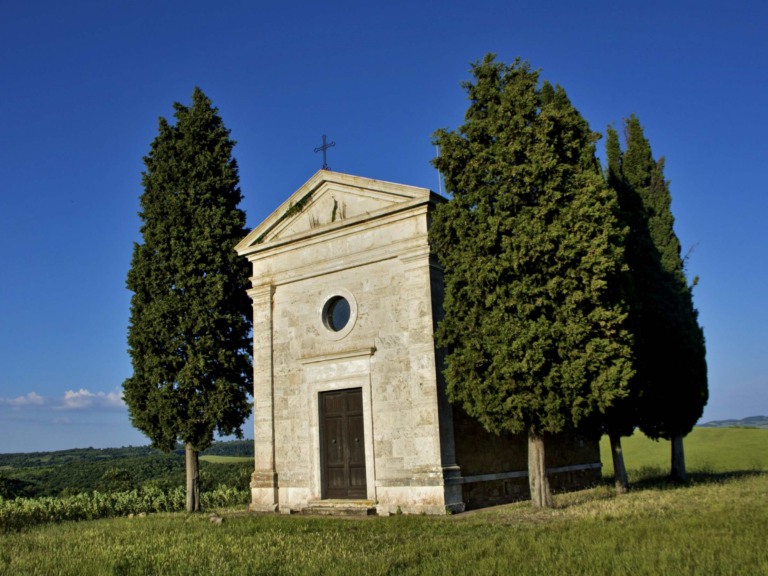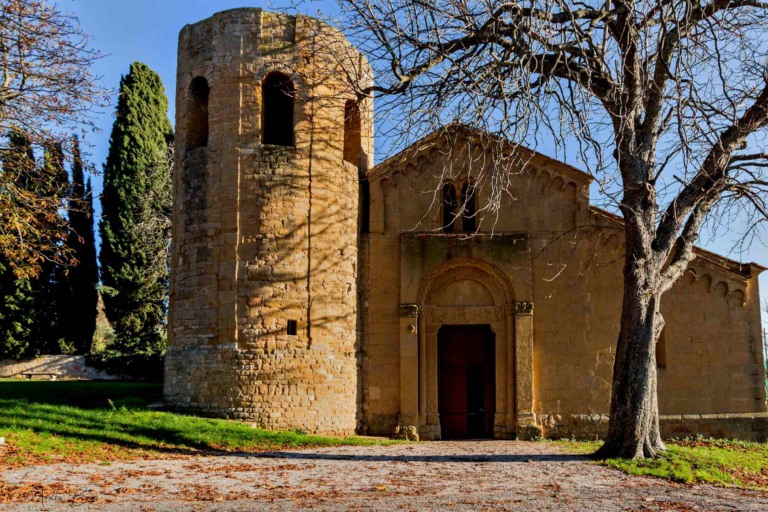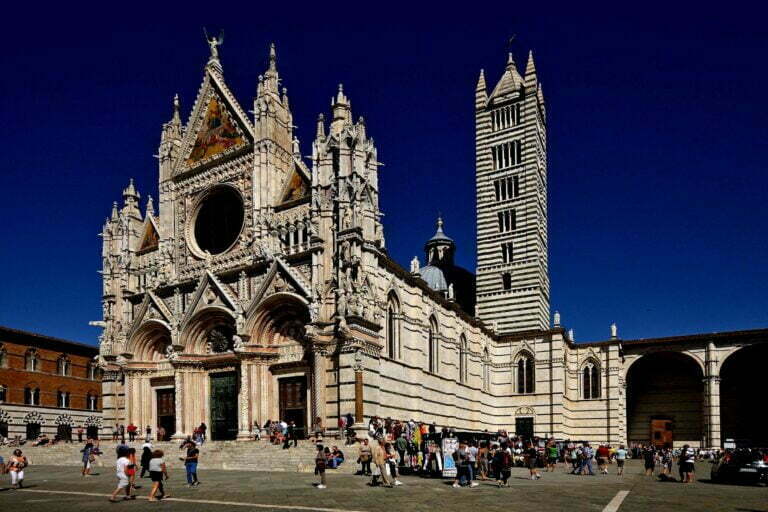The Historic Centre of Florence is a UNESCO World Heritage Site and a cultural treasure trove located in the heart of Florence, Italy. This city is renowned for its artistic heritage, stunning architecture, and historical significance. Here are some of the prominent landmarks you can explore in the historic center of Florence:
Historic Centre of Florence
1. Florence Cathedral (Cattedrale di Santa Maria del Fiore): The iconic cathedral, commonly known as the Duomo, features a magnificent dome designed by Filippo Brunelleschi. Its exterior is adorned with intricate marble panels, and the interior houses stunning frescoes and artwork.
2. Giotto’s Campanile: Adjacent to the cathedral, this bell tower offers panoramic views of Florence. It is a masterpiece of Gothic architecture and is adorned with intricate marble decorations.
3. Baptistery of St. John (Battistero di San Giovanni): Renowned for its bronze doors, including the famous Gates of Paradise by Lorenzo Ghiberti, this baptistery is a symbol of Florentine Romanesque architecture.
4. Uffizi Gallery: One of the most famous art museums in the world, the Uffizi Gallery houses an extraordinary collection of Renaissance artworks, including pieces by Botticelli, Leonardo da Vinci, Michelangelo, and Raphael.
5. Palazzo Vecchio: This medieval palace served as the political center of Florence during the Renaissance. It features ornate rooms, stunning frescoes, and a tower that offers panoramic views.
6. Ponte Vecchio: The iconic medieval bridge spanning the Arno River is known for its shops built along the sides. It has a rich history and offers picturesque views of the river and the city.
7. Pitti Palace (Palazzo Pitti): A grand Renaissance palace that houses several museums, including the Palatine Gallery and the Royal Apartments. The adjacent Boboli Gardens are a magnificent example of Italian-style formal gardens.
8. Basilica di Santa Croce: This Franciscan church is the final resting place of many notable figures, including Michelangelo, Galileo Galilei, and Machiavelli. It is also known for its impressive Gothic architecture.
9. Accademia Gallery (Galleria dell’Accademia): Home to Michelangelo’s iconic sculpture “David,” this museum showcases a collection of Renaissance art and sculptures.
10. Palazzo Medici Riccardi: A palace built by the influential Medici family, it features a splendid courtyard, frescoed interiors, and elegant architecture.
Exploring the historic center of Florence offers an opportunity to immerse yourself in the art, architecture, and history of the Italian Renaissance. The combination of world-class museums, magnificent cathedrals, and charming piazzas makes Florence a captivating destination for travelers interested in culture and history.
Things to do around Historic Centre of Florence
In addition to exploring the Historic Centre of Florence and its many landmarks, there are several wonderful activities and places to visit around the city that provide a well-rounded experience of the region’s history, art, and natural beauty. Here are some things to do around the Historic Centre of Florence:
11. Piazzale Michelangelo: This panoramic terrace offers breathtaking views of Florence and its iconic skyline. It’s a great spot to watch the sunset, take photos, and appreciate the city’s beauty from a different angle.
12. Boboli Gardens: Adjacent to the Pitti Palace, the Boboli Gardens are a magnificent example of Italian Renaissance garden design. Stroll through the lush greenery, fountains, sculptures, and shaded pathways.
13. San Miniato al Monte: This beautiful church is located on a hill above Piazzale Michelangelo. Its stunning Romanesque architecture and the adjacent cemetery offer peaceful surroundings and sweeping views.
14. Fiesole: A charming hilltop town near Florence, Fiesole offers a quieter atmosphere and stunning views of the city. Explore its ancient ruins, Etruscan walls, and local crafts.
15. Chianti Wine Region: Take a day trip to the renowned Chianti wine region, located just outside Florence. Enjoy wine tasting at local wineries, visit picturesque villages, and soak in the Tuscan countryside.
16. Piazza della Signoria: While within the historic center, this square is an essential place to visit, surrounded by impressive sculptures and historic buildings.
17. Mercato Centrale: Immerse yourself in the local food scene by visiting the Mercato Centrale, a bustling indoor market where you can sample fresh produce, cheeses, meats, and other Italian specialties.
18. Ponte Vecchio Shops: Along the Ponte Vecchio, you’ll find a variety of jewelry shops. It’s a great place to shop for unique souvenirs or admire the craftsmanship.
19. Cooking Classes: Join a cooking class and learn to prepare traditional Tuscan dishes. Many local chefs and cooking schools offer hands-on experiences.
20. Day Trips: Florence’s central location makes it a convenient base for exploring other nearby cities and attractions. Consider day trips to Siena, Pisa, Lucca, or even the Cinque Terre coastal region.
21. Opera or Concert: Florence is a city with a rich musical heritage. Attend an opera performance, classical concert, or chamber music recital to enjoy its cultural offerings.
Whether you’re interested in history, art, gastronomy, or natural beauty, the area around the Historic Centre of Florence offers a diverse range of experiences that will enhance your visit to this enchanting part of Italy.
How to get to Florence Italy from Rome
Traveling from Rome to Florence is quite convenient and can be done by train, bus, or car. Here are the most common ways to get to Florence from Rome:
22. Train: The train is often the preferred mode of transportation between Rome and Florence due to its speed, comfort, and frequency. The high-speed train service is operated by Trenitalia and Italo.
The journey takes around 1.5 to 2.5 hours, depending on the type of train you choose. Trains depart from Roma Termini station in Rome and arrive at Firenze Santa Maria Novella station in Florence.
23. Bus: Buses are another option, though they are generally slower than trains. Several bus companies offer routes between Rome and Florence, and the journey can take around 3 to 4 hours. Buses usually depart from Rome’s Tiburtina station and arrive at various points in Florence.
24. Car: If you prefer to drive, you can rent a car and take the A1 Autostrada del Sole, which is the main highway connecting Rome and Florence. The distance is around 280–300 kilometers (175–186 miles), and the journey takes around 3 to 4 hours, depending on traffic and stops.
25. Flights: While flights are available, they are not commonly used for this route due to the short distance and the availability of efficient train services. Taking a flight might be more time-consuming when you factor in airport security, check-in, and travel to and from the airports.
Overall, taking the train is usually the quickest and most convenient option, allowing you to enjoy the scenic countryside while traveling comfortably between these two iconic Italian cities. It’s advisable to check the schedules and book your tickets in advance, especially during peak travel seasons.




